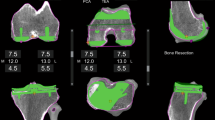Abstract
This paper describes a nonstandard procedure for total knee replacement (TKR), based on the use of modern tools such as computers, electronic sensors, and robots, to achieve accurate and optimal implant results. The intervention is planned on a standard PC connected to the CT scanner. Dedicated software shows the surgeon limb alignment and knee status and assists in the choice of the best prosthesis. The intervention is then performed with a new device and surgical procedure. At first the femur and the tibia are fixed to the operating table with a special clamp and the knee bones are exposed with the standard technique; then the surgeon digitizes the shape of the joint and the computer transfers the planned surgical strategy to a dedicated surgical robot. Resections are performed by the surgeon on a constrained guide held by the robot. In this paper we summarize the main results on the system performances, and discuss the clinical implications of this new technology in the operating room. Preliminary experiments on cadavers and volunteers show that this methodology can improve the accuracy of the implant to 2.5 mm and 2°, reduce operating time and surgical errors, and may represent a challenging alternative methodology for TKR. © 2000 Biomedical Engineering Society.
PAC00: 0707Tw, 8780-y
Similar content being viewed by others
REFERENCES
Bargar, W. L., A. Bauer, and M. Börner. Primary and revision totalhip replacement using the Robodoc system. Clin. Orthop. Relat. Res.354:82–91, 1998.
Delp, S. L., S. D. Stulberg, B. Davies, F. Picard, and F. Leitner. Computer-assisted kneereplacement. Clin. Orthop. Relat. Res. 354:51–56, 1998.
Ducheyne, P., A. Kagan, and J. A. Lacey. Failure of total knee arthroplasty due to loosening and deformation of the tibial component. J. Bone Jt. Surg. 60:384–391, 1978.
Fadda, M., D. Bertelli, S. Martelli, M. Marcacci, P.Dario, C. Paggetti, D. Caramella, and D. Trippi. Computer-assisted planning for total knee arthroplasty. In: Computer Science n. 1205,Proc. CVRMed–MRCAS'97, Grenoble: Springer, 1997, pp. 620–628.
Fadda, M., M. Marcacci, and S. Toksvig-Larsen. Improving accuracy of bone resections using arobotics tool holder and a high-speed milling cutting tool. J. Med. Eng. Technol.22:280–284, 1998.
Fadda, M., P. F. La Palombara, S. Martelli, A. Visani, M. Marcacci, and C. Paggetti. Computertemplating and robotics bone machining for total knee arthroplasty. In: Computer-Assisted Orthopaedics Surgery (CAOS), edited by L. P. Nolte and R. Ganz, Hogrefe & Huber, 1999, pp. 174–183.
Fleute,M., S. Lavallée, and R. Juliard. Incorporating a statistically based shape model into a system for computerassisted anterior cruciate ligament surgery. Med. Image Anal. 3:209–222.
Goldberg, V. M.Controversies of Total Knee Arthroplasty. New York: Raven,1991.
Huiskes, R. Somefundamental aspects of human joint replacement: Analysis of stresses and heat conduction in boneprosthesis Structure. Acta Orthop. Scand. 51:185, 1980.
ISO60601–1. Electrical Medical Devices SafetyRequirements: International Organization for Standardization, Geneva, Switzerland,1991.
Julliard, R.,S. Lavallée, and V. Dessenne. Computer-assisted reconstruction of the anterior cruciate ligament. Clin. Orthop. Relat. Res. 354:57–63, 1998.
Krackow, K. A., L. Serpe, M. J. Phillips, M. Bayers-Thering, and W. M. Mihalko. A new technique for determining proper mechanical axis alignment during total knee arthroplasty: Progress towards computer-assisted TKA. Orthopedics22:698–702, 1999.
La Palombara, P. F., M. Fadda, S. Martelli, and M. Marcacci. Minimally invasive 3Ddata registration in computer-and robot-assisted total knee arthroplasty. Med. Biol. Eng. Comput. 35:600–610, 1997.
Leitner, F., F. Picard, R. Minfelde, H. J. Shulz, P. Cinquin, and D. Saragaglia.Computer-assisted knee surgical total replacement. In: Computer Science n. 1205, Proc. CVRMed– MRCAS'97. Grenoble: Springer, 1997, pp. 629–638.
Moreland, J. R. Mechanisms offailure in total knee arthroplasty. Clin. Orthop. Relat. Res. 226:49–64, 1988.
Paggetti C.,T. Ciucci, E. Papa, B. Allotta, and P. Dario. A system for computer-assisted arthroscopy. In: Computer Science n. 1205, Proc. CVRMed–MRCAS'97. Grenoble: Springer, 1997, pp. 653–662.
Radermacher, K., F. Portheine, M. Anton, A. Zimolong, G. Kaspers, G. Rau, and H.-W. Staudte.Computer-assisted orthopaedic surgery with image-based individual templates. Clin. Orthop. Relat. Res. 354:29–38, 1998.
Rand, J. A. Total Knee Arthroplasty. New York: Raven,1993.
Sati, M., J. A. de Guise, and G. Drouin. Computer-assisted knee surgery: Diagnosticsand planning knee surgery. Comput. Aided Surg. 2:108–120, 1997.
Smith, S. L., andJ. N. Mosier. Guidelines for Designing User Interface Software. MITRE Corp.,1986.
Taylor, R. H., and S. Lavalée. Computer Integrated Surgery. Cambridge, MA: MIT,1996.
Taylor, R. H., L. Joskowicz, B. Williamson, A. Guéziec, A. Kalvin, P. Kazanzides, R. vanVorhis, J. Yao, R. Kumar, A. Bzostek, A. Sahay, M. Börner, and A. Lahmer. Computerintegrated revision total hip replacement surgery: Concept and preliminary results. Med. Image Anal.3:301–319.
Troccaz, J.,M. Peshkin, and B. Davies. Guiding Systems for computer-assisted surgery: Introducing synergetic devices and discussing different approaches. Med. Images Anal.2:101–120, 1998.
Wright, T. M.,and D. L. Bartel. The problem of surface damage in polyethylene total knee components. Clin. Orthop. Relat. Res. 205:67–74, 1986.
Peer revision IGOS Hip Surgery. Deliverable 29 IGOS II HT 94–98, 4010 HC, Compendium of projects; http://www.ehto.org/ht–projects/compendium/index
Author information
Authors and Affiliations
Rights and permissions
About this article
Cite this article
Martelli, M., Marcacci, M., Nofrini, L. et al. Computer- and Robot-Assisted Total Knee Replacement: Analysis of a New Surgical Procedure. Annals of Biomedical Engineering 28, 1146–1153 (2000). https://doi.org/10.1114/1.1313774
Issue Date:
DOI: https://doi.org/10.1114/1.1313774




